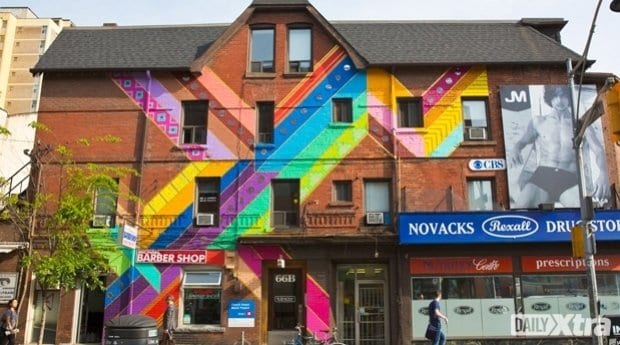What did WorldPride leave behind?
Though the festival didn’t require the amount of new infrastructure demanded by the Pan Am Games, for example, WorldPride did see some changes come to the Church-Wellesley Village. Xtra took stock of what’s new in the wake of the largest Pride celebration Toronto has ever seen.
The Church Street Mural Project
In place of the bare walls, 11 murals now decorate several buildings along Church and Wellesley streets. The project was conceived as part of the legacy for WorldPride, in the hope of sprucing up the area.
Sam Tran, who owns the Ho Team Beauty Salon near Church and Wellesley streets, as well as several other adjacent businesses, has noticed a decrease in graffiti in the alley behind the shop since the murals went up. “It’s a little bit less sketchy,” Tran says.
Rainbow crosswalks
The festive, rainbow-patterned crosswalks installed at Church and Alexander streets and Church and Isabella streets just before WorldPride grabbed the most attention of any of the improvements to the area.
Their addition was reported all over the world, and images of the crosswalks were shared frequently on Twitter and Facebook. “[They are] wonderful dramatic markers,” says Shawn Micallef, a senior editor and co-founder of Spacing magazine. “When people arrive there they can tell that this is the LGBT village a little bit more than before.”
Barbara Hall Park
The $1.6 million renovation to the space formerly known as Cawthra Park made headlines when some speculated it wouldn’t be ready in time for WorldPride. But the park opened on June 19, in time to host the AIDS candlelight vigil and The 519’s Green Space events, including the always-popular Starry Night event, which packed the park this year — people were being turned away from the door by 11pm.
Councillor Kristyn Wong-Tam says that many of the new park features — the programmable LED net lighting, the wood deck area and the pavers that integrate the sidewalk out front into the park — are a first for Toronto. “This park has the iconic urban references of what a park sitting in the city should look like and can be,” she says.
Wong-Tam rejects claims that project costs ballooned, saying that the budget increases were intentional and in line with community requests made during consultations in early stages of the planning process. “This was a very sound investment of money for public infrastructure,” she says.
The community spirit
Micallef believes that the size and scope of this year’s Pride can only be repeated going forward.
“The physical and spiritual civic space that Pride took up this year — it just got bigger,” he says, pointing out that Pride flags were waving not just in the Village, but all along Bloor Street and in corporate chain restaurants like Jack Astor’s. Some official events, like Nuit Rose, a queer arts festival that took place before WorldPride, were held in spaces right across Toronto.
“I think it could probably keep taking up that space,” Micallef says, adding that as a result, the zone of acceptance for the LGBT community has expanded outside the Village in demonstrable ways.
However, while Pride gets bigger, Robert Teixeira, a member of Queer Ontario, worries about the impact it might have had on the people who live in the neighbourhood.
Just before WorldPride started, Toronto Police Service deployed 24 additional constables, a staff sergeant and four sergeants into the Village and surrounding area, on bicycles and on foot, as part of the TAVIS anti-violence community mobilization program throughout the summer. Groups including Queer Ontario and the Ontario Coalition Against Poverty raised concerns that this may lead to increased policing of marginalized people who live near the Village.
A Toronto Star investigation published last year found that TAVIS officers, who have more contact with the public, also “card” black people at a higher rate than other police units. According to Toronto police, TAVIS officers patrolling the Village made 18 arrests and laid 44 charges in the first week of the initiative, which started June 16.
Teixeira worries that this kind of community policing could set a precedent in advance of the 2015 Pan Am Games — the athletes’ village for the event sits at the base of Jarvis Street, on the waterfront. “Other people have said that this could be a lead-up to more intensified forms of policing to cleanse the city of ‘undesirables,’ so called, because of the attraction for tourism these events bring,” he adds.
Teixeira hopes that there will still be space between the parties and large-scale events for the activists and artists who helped build Pride to continue to express themselves. He says some members of Queer Ontario now see Pride as a branded spectacle and less of a political act.
For Micallef, the fact that so much of civil society participated in the parade makes it political. “People wonder if Pride is still political, and at moments like that, it feels really political and relevant, as much as it is fun and a great party,” he says.
The breadth of participation also acts as a rebuke to politicians who may try to cause a moral panic, he adds, such as Toronto school trustee Sam Sotiropoulos, who publicly took issue with nudity at the WorldPride parade.
The most lasting legacy of WorldPride may be that it has cemented the Village as the heart of Toronto’s LGBT community, even as events expand outside its geographic bounds and the makeup of the area changes with each new condo tower.
“I think Church will now play a role as Chinatown does, as Little Italy does and Greektown does,” Micallef says. “It might not be a completely Greek population, and not that many Greeks probably live along the Danforth anymore, but the strip remains as a strong beacon of that community.”


 Why you can trust Xtra
Why you can trust Xtra


